Motoring Icon: The Apex Interviews Tiff Needell
On this week's episode of the Apex, we are joined by the legendary Tiff Needell. Tiff has competed at Le Mans 14 times, climbed the single-seater ladder all the way to F1, and competed in touring cars, British Rallycross and the 24 Hours of Daytona. He also commentated alongside Murray Walker and entertained the nation with his work on Top Gear and Fifth Gear.
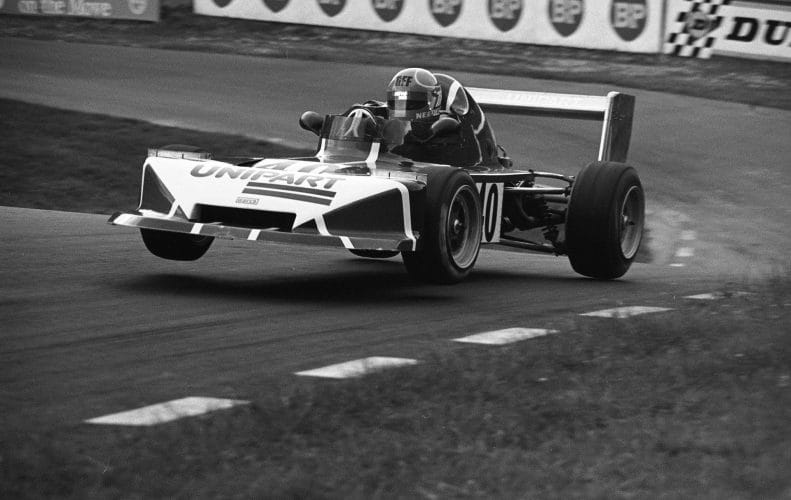
He joins us today to talk about his life in cars, the ins and outs of competing at events like Le Mans, and what it was like to race in such an incredible era of motor sport.
Archie Hill interviews Tiff Needell for The Apex by Custodian. Recorded and produced by Archie Hill. Transcribed by David Marcus. Edited by Archie Hill, Jeremy Hindle & Charles Clegg.
Tiff, welcome to the show.
Thank you very much. Thank you for that wonderful build up. There's too much to talk about, that's always the trouble with all those different titles I have done.
You don't really need an intro either Tiff, everyone knows who you are! One thing that I did notice when I was doing my research was that you grew up near Goodwood and you were able to watch Mike Hawthorn, Stirling Moss, Jim Clark, all race.
Yes, I was born in Havant, very near Goodwood, but that was only because my mother's mother lived there. In the old days the dad never came to that birth or anything like that, so the mothers would very often go to their mothers to be looked after. So I was dragged straight back to Weybridge where my dad had rented a flat. We lived in the same flat for 20 years. My dad was really good at making money living in Weybridge, Surrey. Everyone thinks I am yet another kid with a silver spoon, when you say I lived in Weybridge, oh yes, rich dad, but in fact Dad rented a flat in Weybridge. He could have bought an acre for £2.50 and it would have been worth £2.5 million, but he didn't.
But the Needell passion for speed really began at Brooklands when Dad went there before the war. He did an auto test at Brooklands, so he actually competed at Brooklands, maybe not on the banking. Of course after the war when Brooklands was closed, then Goodwood opened and Dad did two of the first members' meetings. Three lap handicap races, he had an old V8 Ford, a battered old thing, and put the windscreen flat and no crash helmet, put his aviator shades on to look cool and did three lap handicaps. Then of course as soon as he had a family, mum banned him from racing, not that he really had any money to, and he would take us, as soon as I could walk, and we were dragged to Goodwood and started spectating in the mid-50s and, as you said, watched Stirling Moss and Mike Hawthorn, then of course Jim Clark came along and he became my huge hero. So yes, my passion began at Goodwood very much so.
I imagine the impression that watching those races had on you in terms of seeing them race, and then being like, that's what I want to go and do.
Oh, absolutely, I crawled up the banking. That's why I love going back to it. I was in floods of tears. My Goodwood revival TV bit I did for Top Gear, you can see it on YouTube now, genuine tears because Lord March had recreated my dream. I actually tested there. We did a lot of testing in Formula 3 in 1979 so I had driven the track, but when I walked into that circuit, it was the same as when I walked in as a five-year-old. The banking on the exit of the chicane is the first banking I clambered up as a five-year-old and peered over the top and saw these loud, noisy, smelly machines being wrestled through the chicane. That was it, I just wanted to be a racing driver. That was it. Never going to be because there was no money. No money in the family so it was never going to happen.
Then the opportunity to actually go racing didn't come until you won a Formula Ford in an Autosport Magazine competition.
I still can't believe it happened. It is just so bizarre. It's a Hollywood story, because when I left school in the summer of 69, I raided my post office account for all the money I had earned cutting grass and cleaning cars of the neighbours and borrowed mum's Morris 1000 and went out to Brands Hatch, the racing school. I spent a couple of years there just handing over my money to Tony Lanfranchi to do five more laps in a single seater for five pounds. I did a couple of school races in 1970, so I had sort of raced, but I just thought that maybe if I met a millionaire or preferably a millionairess in Weybridge, they would sponsor me because they saw the effort I was making. But eventually, instead of a millionairess, it was the Autosport Magazine competition that made it all happen by winning that Formula Ford Lotus 69F.
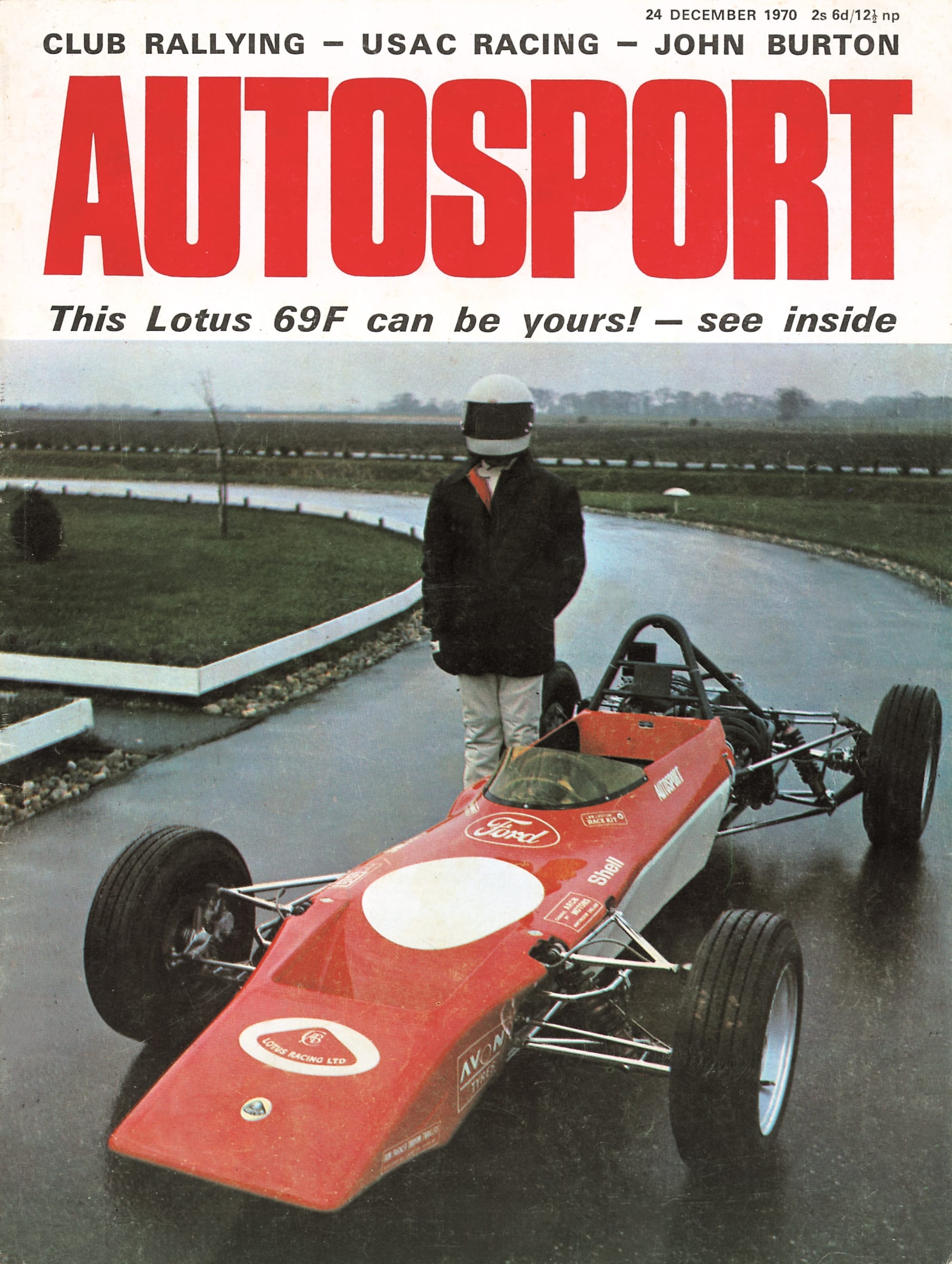
And it was a competition you actually had to put a fair amount of effort into as well.
Oh yes, it wasn't one of these easy things. They were very popular in the late 60s. Whatever the product was, they would create 10 things about that product and you had to put them in order of importance. The Lotus competition was preparation for a motor race, so you had to put the most important things in the right order, and then experts would decide the correct 10 in their right order, and you would buy an extra line, it used to be a shilling a line, I think it was two shillings, I can't remember. So I bought about 20 lines, which was a lot of money back then because I didn't earn anything. One of my lines was closest to what the judges thought, and I won the car. Not that I knew anything about preparing a car for a race mind you.
Well you say that, but you came from a civil engineering background as well, did that help with the mechanical side of things?
No, I don't think so. My motorbikes, they used to fall apart regularly or I used to fall off them regularly when I was 16. I just did things by trial and error. It's quite funny actually when I won the Lotus, because there was no money with it. It was a brand new trailer, a course at the Jim Russell Racing School, but no sponsorship. I owned a rusty Morris 1000 Traveller by then and I had to scrape the rust off the back. I bought a Witter tow bar and bolted it on and then got the trailer on the back. When I first changed the gear ratios, I thought I'm going to change the gear ratio. Not that they had any spare gear ratio, I had to buy one more top gear. I had a friend with a pen and paper, as I pulled the back off the gearbox, he wrote down the order the bits fell out, and I just about put it back in the same order. The mechanical knowledge was something I learned and I had to learn fast because I couldn't afford a mechanic or a preparation company. I was a civil engineer five days a week, a mechanic in my little rented lock up five nights a week. Then at the weekend I was the van driver, the mechanic and the racing driver. So started my long climb up the ladder, but it was wonderful times.

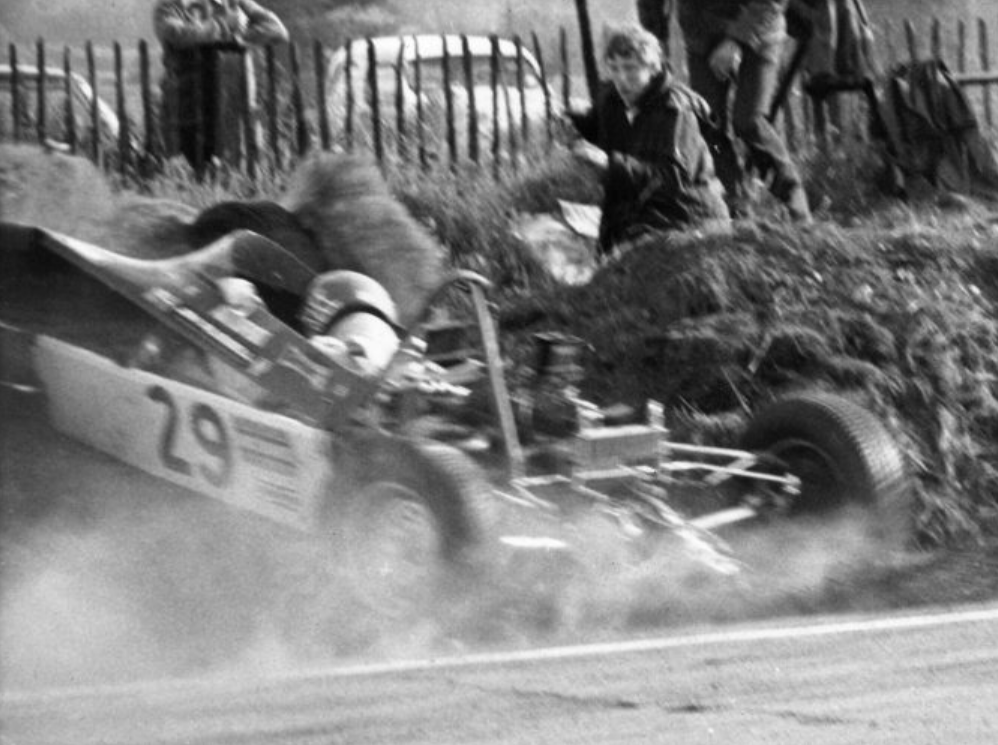

First crash and first win Source: Tiff Needell Archives
I think you also got some mechanical experience fixing your mother's car at some point, didn't you?
Well yes, that was the Morris 1000 I used to practice sliding roundabouts and once fell off the road in Burwood Park and went over the top of some rocks. That was a long story. Have I written that story in my book? I don't know.
You did yes, I think she was a bit surprised when...
When she found the rear carpet was glued down because I drove it, I was at school and there was a sixth form, there was a school workshop and I went back on the weekend and we welded up the floor with a bit of padding and glued the rear carpet down because it had landed on top of this flipping rock, punched a hole in the floor. When she couldn't unglue the carpet, she sussed the problem.
Then all that hard work paid off because you did eventually work your way all the way up the single seater ladder and made it to F1. When you were on the grid for that first F1 race with Ensign, was that the ultimate realisation of your racing driver dream?
Yes, that was just incredible. I do have to actually today in fact put a couple of links in there, because of course it was a Unipart Formula 3 Team. I was voted the most promising young driver like the Autosport Awards but today it's the Grosvenor Awards. That got me the professional drive in 1977 with Unipart. But then in 1979 I got this lift up to the British Formula One Championship with the Durex Scholarship, and this car was prepared by Graham Eden, who sadly passed away just last month. I only learned of it just yesterday. So one of those incredibly lucky links, I won the Autosport Magazine and I got the Grosvenor Award and I got the Unipart Formula 3 drive and then this Durex Formula 1 car for that Aurora British Championship, which they were year old Formula 1 cars. Mine was three years old, so it got me driving a Formula 1 car. On our debut in Zolder I finished second place, and this was Graham Eden that had bought it and ran it. He was the mechanic on his own. He was a wonderful man, mechanic, racing driver, and sadly passed away last month.


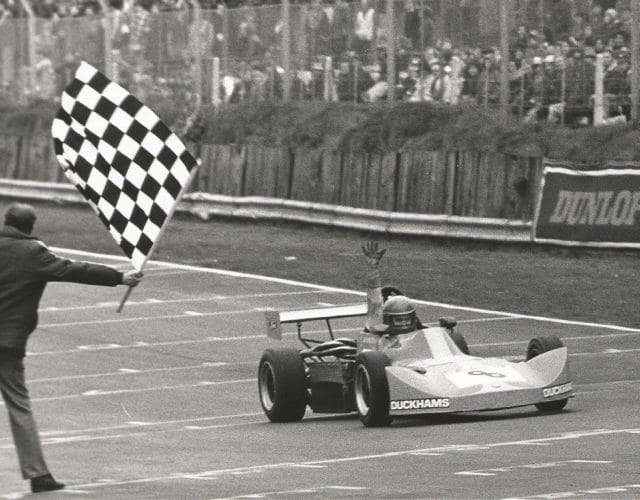

Durex Debut, Flying in Formula 3, Formula Ford 2000 win, James Hunt Source: Tiff Needell Archives
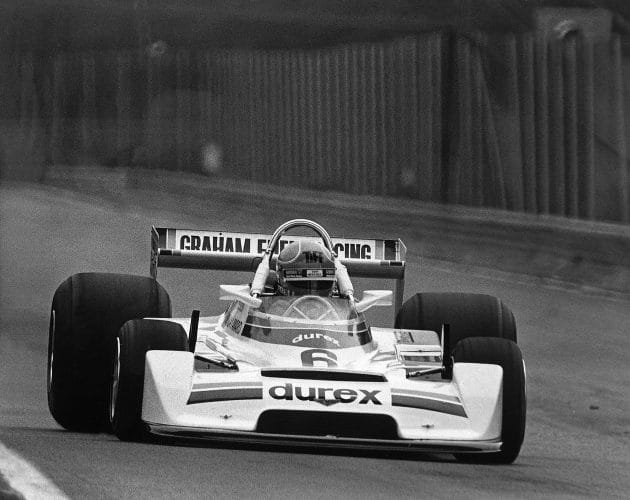
So anyway, yes, there we were. Having got there, Graham Eden, all these people I must to remember to thank and helped me so much. Yes, I got to the grid again, called in at last minute. I had half a day's testing at Donington, which didn't really relate to Zolder, before I went out to try to qualify, because of course in those days, 30 cars used to turn up and only the fastest 24 got the grid. So I was petrified of not even qualifying but managed to get through and ended up on the last row, I think I qualified 23rd, which was the same place as Clay Regazzoni had qualified, but of course he had the awful accident that gave me the opportunity. Of course there was no second car so nobody could compare my lap time, so I was very much on my own. I felt really chuffed at 23rd, but then when I sat on the grid and looked beside me, Emerson Fittipaldi!, me, Emerson Fittipaldi!, of course was one of my schoolboy heroes in a Lotus. He was almost the new Jim Clark to me in many ways, when he arrived at Lotus and did Formula Ford and Formula 3 and then he was promoted very quickly.
I sat on the grid, I actually started singing or humming the Grand Prix theme tune. I fired up the car and there I am sitting, revving, looking around me and I was starting to go, doom da da doom, da da. I thought I was still watching it on telly, because it happened so quick. I was only a substitute, they wanted Jan Lammers, Jan Lammers had been the superstar at Long Beach the race before. He qualified fourth I think, and the Unipart Ensign had a numerical investor and he was obsessed with Jan Lammers. Jan wasn't free because he was standing in for Marc Surer. Marc Surer broke a leg. You had so many opportunities in those days, breaking a leg, you get a few Grand Prix. But I knew that once Marc Surer was fit, Lammers would be kicked out of ATS and he would be in as it happened with Ensign. But it destroyed his career, poor man, because the Ensign as I tried to tell Mo Nunn, was a bit of a rubbish car at the back of the grid. But then Jan came in, and he didn't even qualify for about six Grand Prix's on the trot, he couldn't even make the 24, so it wasn't that good a car. But to me, it was the most magnificent, beautiful Grand Prix car, that I still have photos of and look at.
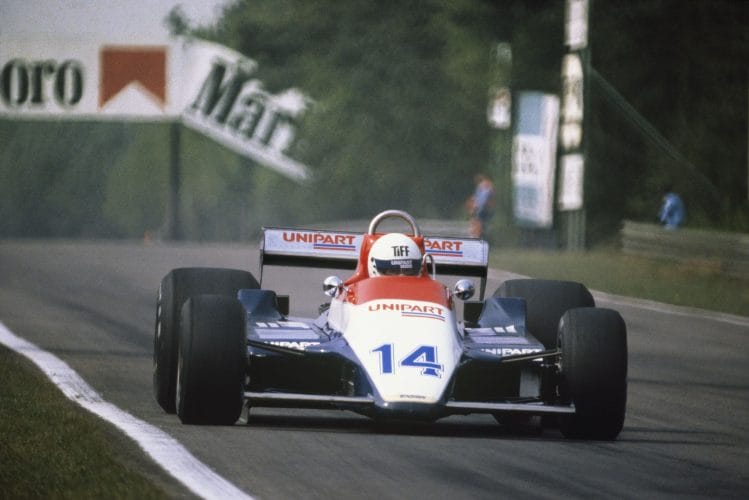
But yes, I had got the top of Everest. It was just ridiculous for me to be a racing driver. Now there is only 20. I mean it's ridiculous, there is only 20 in the whole world. I mean, just the Premier League football teams in Britain have a 34-man squad, and there's 20 of them, so that's 640, something like that. That's just Britain, so you imagine the talent, the mountain of talent that tries to become a Grand Prix driver. And of course now this horrible 10-team clique isn't letting anyone else join. There's only ever going to be 20 drivers if they have their own way, and they don't get injured any more as much. Sorry, touch wood, I shouldn't say that, but the opportunities don't come. So just getting to the top of Mount Everest. I didn't stay there for long as Jan was there. Once you reach the peak and you start sliding down the other side, you know it's over. I was so lucky that Group C sports cars was growing and I started 10 years in world sports cars. But being a Grand Prix driver, I have got the watch, not on, it has the Grand Prix Driver's Club with my name on it. That's my most cherished possession and the fact that I did make it to that very exclusive club. Didn't stay there for long, but in fact, I picked up the stats of 1980, talking about drivers getting a chance, which they don't get any more. There were 41 drivers, including me, that tried to qualify or had the opportunity that year, so there was so much more chance of getting a race, and it's a shame now that these kids are all giving up at 20 or 21. 'I am too old, I will go and be a GT racing driver, I am never going to be a Grand Prix driver, I am too old.'
I mean, you did get to drive at Monaco though, that must have been pretty special, of all the races?
Yes, that was epic. I looked through Stefan Johansson's interview. I was a good friend of Stefan, we raced Formula 3 together, and it jumped out when he was talking about those 1,500 HP qualifying laps. He had wheelspin all the way up the hill towards the square and it was just crazy. Even with my mere little 550 HP, I still remember that climb up the hill, Sainte Devote at the bottom, the fact that it weaves, as Stefan was talking, you could only ever see 300 yards ahead, and it just kinks left and right. Of course you come to this crest over the top where you have to brake, just along the crest preferably, but not over it. So yes, many amazing memories, just driving a Grand Prix car around Monte Carlo was very, very special.
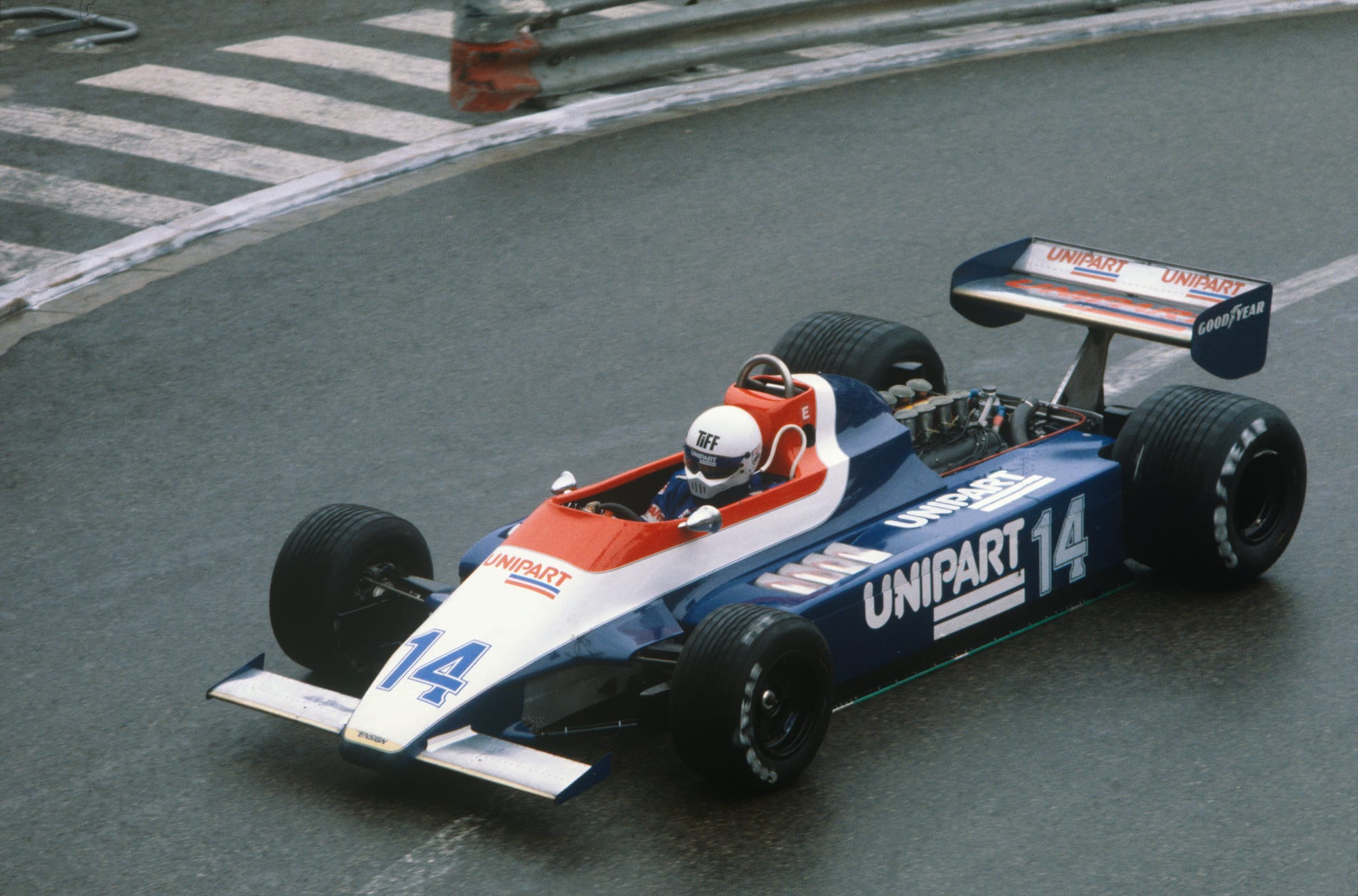
Did you ever get the chance to speak to Carlos Reutemann for holding you up?
No. I wish I had, Mr Reutemman! I mean the fuss they get today, which is quite right, for people holding you up, but yes, on my one lap with my new tyres, I had to switch to a spare chassis as well, because I actually qualified, this was the most annoying thing. I was 19th in the wet session on the Thursday. So I was on the grid and only 20 cars got on the grid in Monaco out of the 30 starters. My first flying lap I caught Reutemann wandering around the swimming pool area, and he just blocked me deliberately because he didn't want some rabbit getting in his way. Then of course he started a lap and disappeared out of sight, so I thought that's good, I am on a clear lap now, I could qualify. Came around the swimming pool and there he was again! Apparently he was famous, if he had a bad lap he would abort it completely. He just weaved again and just stopped me getting by again. The third time I came around I think he wasn't there, so I crashed because I couldn't believe he wasn't there! But by then the tyres had gone that had the best lap. Yes, so Mr Reutemann holding me up, I could have been a star, I could have got through, could have made it.
But actually, for the non-qualifying club that year, it was quite classy. Because it was Keke Rosberg and John Watson didn't qualify so I was in good company. In fact that was the last Grand Prix and I think the first one since the early 1950s that didn't have a British Grand Prix driver on the grid, because myself and Watson were the only ones from Britain. So a good pub quiz, the last time there wasn't a British driver on the grid was the 1980 Monaco Grand Prix.
And then from Formula One, you also spent a lot of time in Japan, doing sports car racing over there. What was that like?
Well I did Formula 2 first, that was the place for money when the career was going off. There weren't many, it was the beginning of the great Japanese invasion when I earned about £10,000 a year. I think by the time Eddie Irvine had fleeced everyone, he was on about £350,000 a year. The Gaijin Racing Drivers Club, I was a founder member when we started that, Geoff Lees, myself and Eje Elgh, the Swedish driver, were the only three when it all began in 1979.
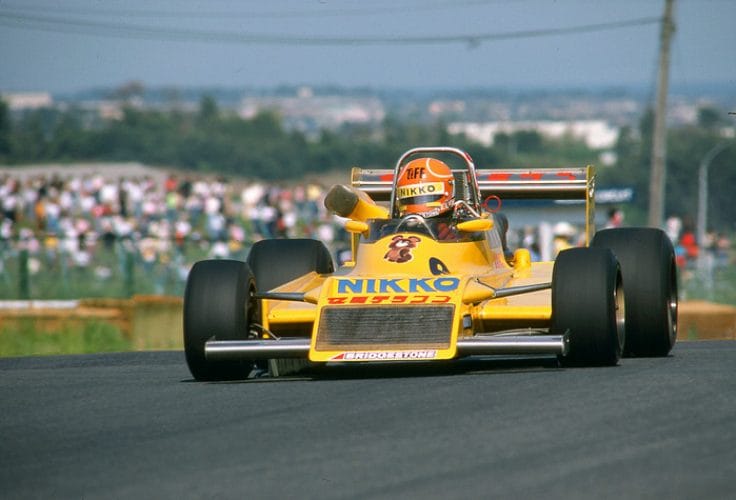
That must have been quite an extraordinary experience going over there and racing though?
We were going cheapest tickets as possible, and we used to go Aeroflot via Moscow. I remember going to Moscow and these miserable, awful places. You weren't allowed anywhere when you went to the transit lounge and it was a broken down, disgusting place. We went Aeroflot and raced, we stayed in Tokyo, but in those days there were no street signs, it was so foreign back then, the maps for Tokyo you bought were building maps. So you would literally drive around until you found something that you can see in a picture, then you would work out where to go. I got named Tiff the map in Tokyo because I was the best at working out how on earth we can find anywhere.
You have also competed Le Mans 14 times, what makes that such a special race for you?
Again, it's history because I was a true fan. It's where all my heroes raced and all those legendary tales came back. When I was at school I used to do the sweepstake for Le Mans. I had to go around getting 10 shillings out of everyone. It was just this historic race and to go there and drive around the same racing line as Jim Clark and Mike Hawthorn and all that historic racing that comes, that made it special for me. As a racetrack, it's long, got lots of different corners and great straights and I was always quite good on the straights, one of my fortes, but it's a magnificent circuit to drive around, a four-minute lap, huge history. Then this 24-hour race, which was just so special to survive and get to the end of and finish, let alone get on the podium.
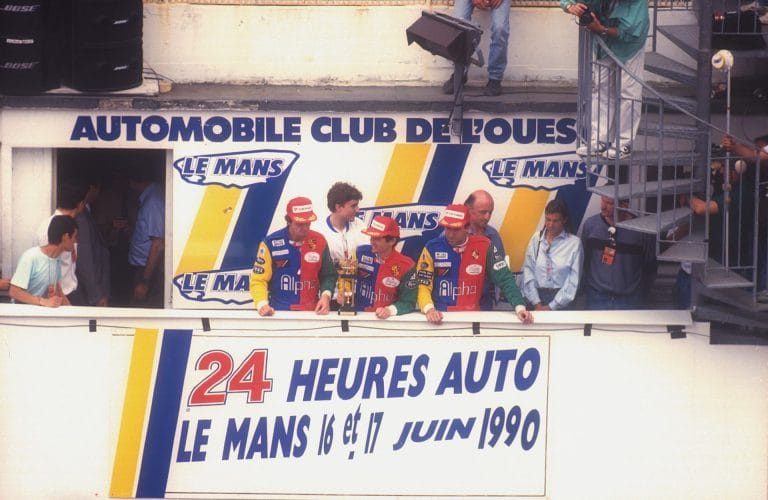
I used to race with amateurs first off, a bit like nowadays, a lot of young drivers in GT racing, you have a rich owner. I had Ian Bracey, a Lloyds underwriter with his IBEC open top sports car for my first Le Mans. Then I had Steve O'Rourke with the EMKA Aston Martin where we led Le Mans in 1985, really briefly in the first stint. So he was the Pink Floyd manager that paid for that car. Then gradually I got to get professional drives and a Toyota factory drive in 1987, 1988 and then Porsche in 1989, and then finally a private, I was back in Japan then by 1990 racing the Alpha in the Japanese Group C in a 962 Porsche. That's the car that the owner took over to Le Mans and we came third on the podium. The only privateer and all the others were factory cars. We were beaten by the two Silk Cut Jaguars. Derek Bell who was racing with me in Japan, but couldn't join me at Le Mans because he was factory signed. He finished fourth and then the factory Toyota and the factory Nissan finished out the top six. So it's hard to compare being on the grid at my Grand Prix debut or being on the podium at Le Mans, which was the finest moment, I can never give the answer. They were just both magnificent moments.


Le Mans debut in Ian Bracey's IBEC. Leading Le Mans in 1985 in the EMKA Aston Martin Source: Tiff Needell Archives
That 1990 race must have been very special.
We drove flat out, we single stinted because we didn't have any backup and masseurs or dieticians or fitness trainers. We just drove flat out, myself, Anthony Reid and David Sears. Again, I actually got the other two in when Derek couldn't do it and the Japanese said, well what other drivers can we have for Le Mans? I picked two drivers that were like me, had the talent I knew, but hadn't really had the opportunities to get the results. I was chuffed for myself and for them.

What was the Porsche 962 like to drive?
It was a bit brutal actually, because being a single seater driver, all the Group C cars were a bit hefty and not so agile, and when you have grown up always in single seaters, they are all a bit of a shock. You can't see so well, you've got the A pillar and so visibility is not the same, you can't see your little wheels. But as a Group C car, they were the best. They were heavy steering and a very heavy gear change because they had synchro gearboxes in those Porsches which helped them last so much longer. You couldn't flick through the gears, it was quite a hefty change, so they were hard work physically and of course ground effect started to come in. So we had a lot of downforce, a lot of grip, a lot of G-force, so brutally physical before you got used to them or got fit enough, but magnificently reliable and sure footed.
I had crashed one, I drove a Kremer one in 1985 and the bloody suspension broke on me, put me in the barriers at the Porsche curve, which wasn't so much fun. In 1989, the flipping thing caught fire. Why have I just said they were reliable? Why did I just say that?! I think the factory cars were always very reliable. I had a Kremer one throw me in the wall when the suspension broke. Then the poor Richard Lloyd red car in 1989, 22 hours into the race, really hot weekend, we battled from 15th to 4th in a not very quick car, when a fracture in a new fuel housing that the factory had given out to all the teams, there were about three or four big fires that year because the same cast fuel unit cracked open. So I had to abandon the flaming Porsche.
Was it 1982 as well that you had quite a big accident on the straight, do you remember that one?
That was my second one. That was the Aston Martin Nimrod, my first professional Group C drive that was. The rear bodywork departed going down the Mulsanne Straight at 200 mph. Unfortunately it detached, that was the rear wing, it was a rear hinged tail so I lost the whole lot. My 200 mph racing car became a 200 mph wheelbarrow. Turn sharp right and then sharp left and then in the barriers. That was a sizeable crash but you remember these things because you are so full of adrenaline and concentration in motor sport, when things go wrong, it's amazing things go into slow motion because your mind is there working at double speed to think, what am I going to hit next, so it went on and I remember going backwards.
I missed the first hit to the barrier on the right, spun it around and congratulated myself on how brilliant I was at not hitting the wall, when I realized I was now going backwards down the Mulsanne Straight at about 180 mph, and steering backwards isn't easy. I hit the barrier on the other side and the whole front of the car came up and I thought oh, I am in the trees, I am dead. But luckily it crashed down again and started spinning back across the road. I remember when it was rotating all I saw was debris and smoke, I noticed the two gull wing doors had flown off in that first impact. I remember saying to myself, that's good Tiff, at least when it stops I will be able to get out. So it is amazing. Then of course you jump out and brush yourself off. As everybody on television, when you see Derek Warwick at Monza, wasn't it, running back to the pits to get in the spare car or Martin Brundle in Australia. We don't get shocked because you are concentrating 100% and you have got adrenaline and you are fired up, you don't get shocked when you crash a racing car, which is something the public can't understand.
This was before the chicanes went in as well, wasn't it?
Yes, they came in 1990, which is part of the story of the Porsche, because we were racing at Fuji Speedway when they said we had the chicanes. I had worked out that each straight was now the same length as the Fuji straight. So I said that maybe it would be a high downforce track instead of low downforce, because the Porsche factory said, you all have low downforce, because every year they made a fortune selling the low downforce kits, but I thought no maybe still going to need a bit of grip because now with the chicanes, you can go quicker down the Porsche curves. So we had a wing made up and tested the idea of the low downforce and the high downforce, and decided it would be a high downforce track. So we came with a high wing and lo and behold, that was the way to go.
One of the other things I really wanted to ask you was, I think it was Daytona 1995, Paul Newman was in the race as well and I think you had a tire blowout or something and you gifted him the podium, did you get to speak to him after the race?
I could have asked for some money, couldn't I? No, that was a one of, I have had so many what ifs, so when you are driving not in the factory teams, you are always slightly struggling with money and finance and stuff, but I was in this wonderful Kremer K8, what's his name, Austrian guy (Franz Konrad), I will get there in the end and yes it was about six o'clock in the morning, I was doing this wonderful dawn stint. We had had some troubles early on, we were in third place and I was going faster and faster, the lap times were coming down, and all of a sudden heading into the tri-oval after the turn 4 speedway, I just heard this almighty bang, and the car turned sharp left, but unfortunately for him or luckily for me, there was some big old GTP car right next to me which I managed to hit, which bounced me a bit straight for a while before I ended up rotating into the concrete on the outside of the circuit, right where the start-finish line, and then rolled down, sat in that grass area in front of all the pits and the mechanics, realizing another dream was gone. But Paul Newman flipping well got my third place. You are right, I should have gone and spoken to him.
You should have done! But you did race in such an incredible era of motor sport. There are so many incredible names. Are there any competitors that really stand out to you that you really enjoyed racing against?
Racing with Villeneuve in the Race of Champions, I always so admired him. I was out in that Durex Chevron because in 1979 in the Race of Champions, they mixed the Aurora Formula 1 cars with the Grand Prix cars. I remember he overtook me in qualifying, and it was between Hawthorn and Westfield, or was it Westfield and Hawthorn, I always get those two mixed up, he just went straight down to Westfield ahead, and I let him by and then he was just sideways opposite lock, two wheels over the kerbs, grass, dirt, and he just shot off down Dingle Dell and never saw him again. He was such a wonderfully gifted driver. So I don't really recall, I mean I raced against Jackie Ickx and Derek Bell was my team mate sports car wise.
Single seater wise, I grew up with Stefan Johansson and Eje Elgh who never made Formula 1 and maybe should have done. Nelson Piquet of course was very much my year of the Formula 3, so I was a good friend of Nelson's. That was really my era. But it was only really myself and Geoff Lees. There were very few of us in that era in British motor sport that actually got through to Formula 1. As I said, Monaco it was only me and Watson, we were the only two to qualify. Geoff Lees is one of those underrated drivers I ever raced against. He was really strong and I battled him in Formula Ford and Formula 3 and hated him all along, but we ended up as team mates in Japan and we are big mates now. Derek Daly of course, I raced against a lot in Formula 3. Derek Warwick raced I suppose but they were a year younger than me. Derek Warwick, a lovely man as well, a great driver.
Transitioning slightly, alongside your racing career, you also got involved with the BBC and did some commentating for the F2 and F3 races, what was that like, what was it like working with Murray Walker?
I was another pioneer then, like I was a pioneer for Japanese drivers. I was a pioneer for expert analysts. There weren't many in those days, it was the beginning of that. Now they are everywhere you know. I used to go of course to Formula 2 races in my helmet and overalls trying to get a drive, to pick up a run, spread my word around. I got dragged in with Murray Walker and I had two or three wonderful years with that wonderful man, one of the nicest, I always say he is the nicest man I have ever met in motor sport. I think he is the nicest man I have ever met anywhere in the world. I mean just charming, kind to everybody. So I was his sort of protege in a way. I thought in the end I might end up being the commentator, but he left and ITV took over and I was still a racing driver, so I never chased that too much. But yes, I had a great time with Murray in the commentary box.
Did that in turn lead to your involvement with Top Gear and Fifth Gear?
I think so because Chris Goffey broke his ankle ice skating when he was supposed to test a Formula First racing car for Top Gear, so he couldn't drive, so they said flipping hell, we have to get someone this weekend to drive. So they had my phone number, they had heard me talking so they knew what I sounded like. So someone must have said, let's get Tiff in. So I was summoned to do that one test, only one test, one program, just drive for Chris Goffey. They didn't even show me with my helmet off. I talked while I was driving, they wanted me to do that bit, and I thought before I did it, I thought it looks a bit dull sometimes, this Formula One track, it looks a bit easy sometimes, so I deliberately, on that very first thing, chucked it sideways and looked like I was about to crash every corner, and the producers were so amazed I could do this, that I got asked back to do more and more and more, and then the Top Gear career took off by complete accident. All my little links were always pretty much by luck. I suppose the Unipart drive was because I was the most promising young driver of 1976. The Autosport was a bit of luck and it came through in the end, luckily.
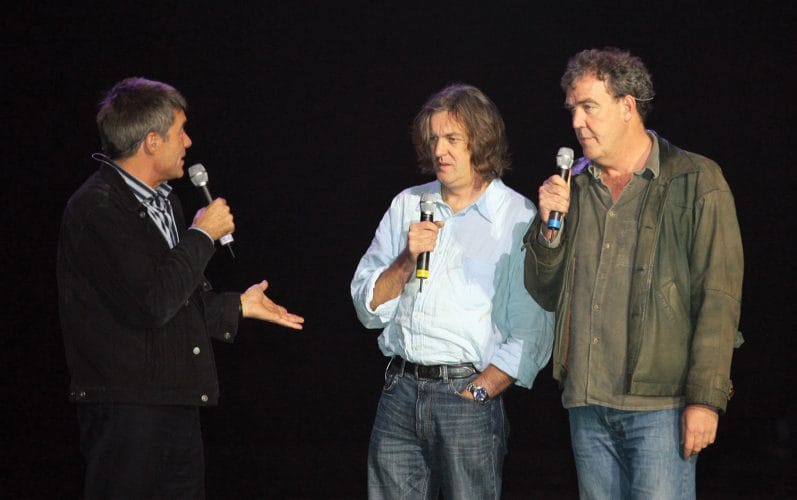
Talking of being a pioneer, that segment you shot with the McLaren F1 for Top Gear, I watched it the other day, it's absolutely fantastic.
It's still what everyone remembers me for, the original Top Gear. Top Gear was on its knees a bit in the beginning of the 1990s. I joined and did my car driving and then they got Jeremy a year later to do his bad comedy that he loves. Then Quentin Wilson came along, Jeremy's mate to talk a lot of rubbish about second hand cars. So it really took off in the mid-90s. And as you said, I did that McLaren test, which everybody still remembers I loved doing. I loved it as well because I was allowed to do the whole story from the beginning of the road car. Whereas nowadays towards the end of my Fifth Gear career, they were all just go out, spin the wheels, get sideways in the middle of the story. I said no, I want to walk around the car, build it up and then have the sideways bit at the end. They let me do that. It was Ken Pollock, the producer at the time that really created the piece and guided me through it, I give thanks to him for helping that happen.
The other one is always when I took Jeremy and Quentin for a ride in the Ford Puma, is the other big YouTube one that everyone watches. But it was a lot of fun. Mid 90s, we had about 6 million viewers, the same as now. We weren't celebrities in those days. It's funny how celebrity has grown now, isn't it? You've only got to have about 1 million viewers and you are a celebrity and you are everywhere. But of course Jeremy left to do his own chat show and Quentin left to sell cars on the internet or something and it died a bit. Then we were taken off air in 2001 or 2002, which is why I then created Fifth Gear. I went off to the Fifth Gear producers and said, well not Fifth Gear but Channel Five. So I brought the whole Top Gear team to Channel Five. Now of course I am on Lovecars because channel Fifth Gear has died a death, so now I am doing Lovecars with my good friend Paul Woodward. We do a podcast every Monday night as well about motor sport over the last weekend, I look back at motor sport. So podcasts, YouTube, whatever next, TikToks or something.

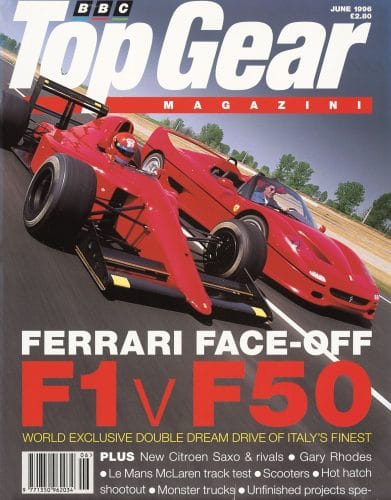


Top Gear and Fifth Gear! Source: Tiff Needell Archives
Stay away Tiff, don't go on TikTok. This kind of goes full circle really, because you talk about those early years at Goodwood, then you have had the opportunity to race there at the Revival as well, how special is that to you?
Every year it's amazing because Lord March, I've got to move him on to the Duke. I always remember there was a Star Wars episode, I don't know why I saw it, where there was a holiday planet, where if you went to this holiday planet, they'd create your holiday in your dreams, so whatever you dreamt of, that would be your holiday. So when Charles rebuilt Goodwood, it was just like my dream. I thought well this is ridiculous, I am now going to be driving my dream, because I am sat in the grandstands and now I am on the track. Of course everything was rebuilt as it was when I was a spectator. The stalls inside with the corrugated fence post, that was as it was and I walked around looking at the cars as I had done, so it was just overwhelming. Then they added the Spitfires and the taxi girls, it just re-created my life as I grew up. So every year he changes something. The driver's changing rooms have got a different theme and there's other things added around the track. When we go to Tesco, the whole supermarket was done with branding as in the sixties, all the prices on it. Now I think it's a lady's hairdressers salon, as it was in the 60s, doing Bouffant hairstyles, and everywhere you look, second-hand cars on it for £10 and six shillings. It's a time warp he's recreated, so every year is different and every year I've got tear in my eye because it's just so magnificent.

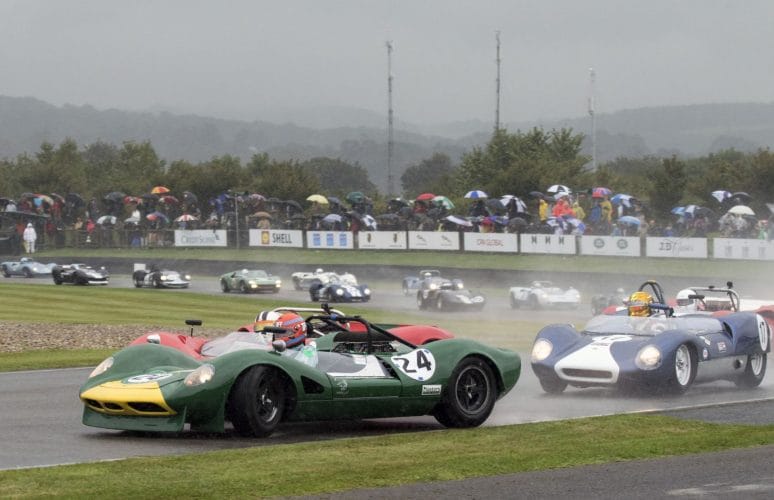
I think it's special for my generation as well. Obviously I wasn't there back in period but to just be taken back and experience it is extraordinary. And also the racing as well, from your point of view, how does that compare?
It's fast. The thing about being one of the Goodwood drivers is that I get given a car each year. So sometimes you are at the back and sometimes you are at the front, but then you negotiate other cars with owners, like I have got John Spiers who I have driven his lightweight E-Type now for two or three years, so I am very grateful to John for allowing me to drive that. I have never been in a single seater yet so I am calling out for a single seater drive. I don't care if it's Formula Junior, Formula 3, Formula 2. But yes, there's magnificent cars. The racing is great and we are all sliding around all over the place, using lots of opposite lock and having to change gear and heel and toe. So these skills that are disappearing from a racing driver's book of skills is a shame, because you can't deny it's so much easier with these flappy paddles, braking and changing down and turning into the corner with all these bits going on was much more of a challenge.
I almost despair when I watch these young single seater boys, they turn into the corner, they are changing down to the apex, then they have got a left foot on the brake (imitates flappy paddle changes). So the gap between brilliant drivers, this is what's happening, especially in a single make formula, you can't actually see talent that easily, because once the very, very good driver looked at the telemetry of the brilliant driver, you can just copy it like a wire ring over electric hoop. So the very, very good driver is now within a tenth of a brilliant driver. So it's so hard, if the brilliant driver isn't in quite the best car or in the best team or the best engineers for his Formula 4 or his Formula GB3 or whatever, the very, very good driver will beat the brilliant driver because he's got a better engineer. So a lot of the skill that was required in my day, has disappeared. So it's become much easier to be nearly on the limit.
You watch those boys go out in Mexico, the four rookies given their rookie drive in FP1, and there Ollie Bearman did stand out to me because I am a huge fan of him. I have never met him, but the other three were all within 1,5 s of the regular driver, but Ollie was 0.2 slower than Hulkenberg. Just did a stunning lap time. He is 18 years old! I always look at the junior single seaters still, and if you look at someone, you look at them in Formula Ford, they keep on winning, some of them go up a step, they win straight away. You can still see the talent coming through. Then I despair when I see someone getting through that really hasn't got the results that deserve it, he's just been steady but he's done three years in Formula 2 and three years in Formula 3, because you can get to be a champion now by experience and knowing how to run a Formula 2 car or Formula 3. But Ollie Bearman will be I am sure Britain's next Grand Prix driver.
Heard it here first.
Hopefully with a Ferrari. Hopefully replacing Carlos Sainz perhaps in 2025, how about that?
That would be pretty cool wouldn't it.
We shall see, there is plenty more talent still coming up and through the ranks.
Unfortunately we are coming up on time Tiff, so I was just going to ask a few quick fire questions, if I may.
Well of course.
What is the favourite race car that you have ever driven?
It should be my Grand Prix car or my Porsche stuff, but it is actually the March 782 BMW that I raced at Hockenheim in my second ever Formula 2 race and I was running third, heading for the podium, not actually second I think, I was going to beat the factory March cars, and they all actually finished on the podium the first time, one, two, three, when the engine broke. Another one, you see another one, another one. I was there, I was going to be a star. It was a Toleman car and I had been in touch with Toleman for a while and they just gave me one race at the end of the year, but it was at old Hockenheim with that magnificent fast corner. It's the last car before ground effect basically. So ground effect ruined the world for me because ground effect became a horrible understeering setup. So the 782 BMW was just drifting through all the Hockenheim corners and I was on top of it, I was at one. It is just when a car really, you wear it and it works, that's the car you like.
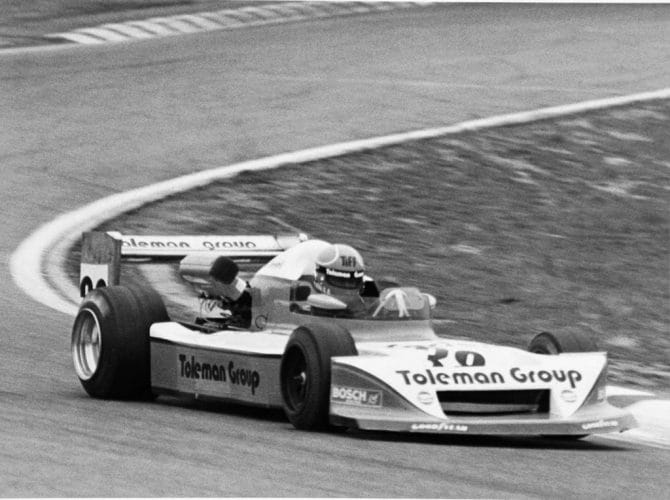
What is your favourite circuit?
That is always a difficult one as well. All the historic Le Mans I love. Brands Hatch Grand Prix track in England. I would actually probably picked Macau near Hong Kong where I had some wonderful races but rubbish results. I should have won it one year and it jumped out of gear and I kissed the wall, that was a hell of a story. Roberto Guerrero and I were racing for the lead. I will finish this quickly. This was one of my so nearlies. It was a Formula Atlantic, they had more power than the Formula 3 cars. I was racing a Japanese Toyota Ralt and Roberto Guerrero was in the Teddy Yip Marlboro Ralt. Roberto Moreno had fallen off at the first corner, he was about 30 seconds behind us. So it was me or him, going to win the Macau Grand Prix, about two or three laps ago. He had actually bent a fin on a wall so I was going to get him. But for the last five or six laps on deceleration at the end of the main straight, it was jumping out of third gear, which is often happening in gearboxes which is slightly out of warn, when you lift off, they jump out.

I was going through the Teddy Yip Esses with about two laps ago, right behind Guerrero's gearbox, and it hadn't done it then, and I just lifted a touch, which is all you had to do to turn into the corner, and pop, it jumped out and just made it run wide, kiss the wall. Broke the wishbone. And later that same lap, about five corners later, Guerrero stuck it in the wall, not realising that I had hit anything, because he was under such pressure from me. So flipping Roberto Moreno is in the books as winning the Macau Grand Prix, that was '79 I think it was, and he was 30 seconds behind us. But anyway, what a magnificent circuit to race around, absolutely stunning. Precision required, and that's what we lose these days with these awful track limits. Because to me, the whole skill of a racing driver is speed with precision. As soon as you are allowed to go into a car park full throttle and come back on again, well that's what a very, very good driver does, whereas the brilliant driver can carry that speed within walls and inches, Senna and stuff around Monaco was just absorbingly precise, so you need those barriers near you, whether they are artificial or how you do it, to get the best driver to look the best. Macau.
Macau, that's an interesting, we haven't had that one before, so that's brilliant. I know you said this changes by the day, but if you had to pick a dream three car garage?
It's a stupid question, let's be honest, stupid question. If you go for your dream cars, I would have a McLaren F1 and a Ferrari Dino, you have to have a Ferrari. But whatever the three, the only I would keep always is a Morris 1000 convertible with the hood down, ready to go out down the pub at the weekend. There will be a Morris 1000 there, convertible. The other two would change. If you want a practical car I would have to have a BMW, a 550 touring, wonderful, it has to be manual. It's a wonderful gearbox in those old BMWs. It would be a BMW touring five series to take the family out in. I always liked Porsche Boxsters, I don't know why I did, but that was a Porsche. Lamborghini Diablo. There are so many wonderful cars, it's impossible to pick. McLaren F1.
McLaren F1! Unfortunately that is all we have time for but Tiff, it's been a pleasure having you on, thank you so much for your time.
Thank you for reminding me of all these things. I have to go back through history sometimes to remember what I actually did.
Well you have done a hell of a lot and it's extraordinary, it really is.
I hope it will keep going, as long as the Duke keeps Goodwood going. I have done every Revival meeting and every Member's meeting so far. I haven't missed a single meeting, so I have done a lot of Goodwood meetings. We did the 25th year I think last time, didn't we? Gosh, I have done 25 revivals. Gosh I must have been young when it started. But videos, I will mention the other video that goes with what we talked about, apart from the McLaren F1. If you are going to watch one Lovecars on YouTube, scroll down and find the one with the Morris 1000 Traveller, because I recreated, I borrowed trailer, because I now bought the Lotus back. The Lotus that I sold in 1973 came back to Britain in 2015 or something, and someone said I have got your Lotus. So I bought it back, it's mine again. I repainted it in the colours as I want it. We have done this film where I borrowed a Morris 1000, borrowed a trailer, we put the Lotus on the trailer, recreating that amazing side of a Morris 1000 Traveller telling a racing car. Tears were in the eyes again. I didn't have a camera back then. I couldn't afford a camera. We certainly didn't have a thing called a mobile phone with a camera on it. Now these kids have, so I had no photographs of it. That's why we recreated it. I had not a single photograph of a Morris 1000. So now you can watch it on this Youtube thing.
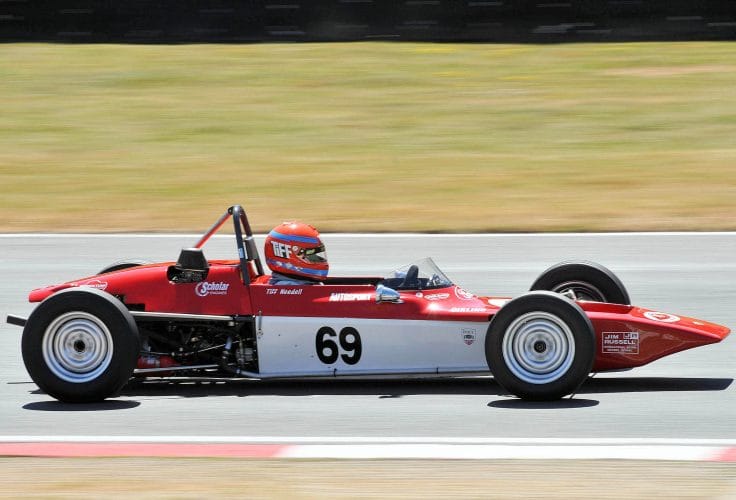
I will put the video in the written version of this interview so everyone can find it.
Put the link in to the Morris 1000, it is my favourite story I have ever made on Lovecars.
Yes, we will get it in there, it's brilliant. Thank you very much Tiff.
All the best, cheers.

